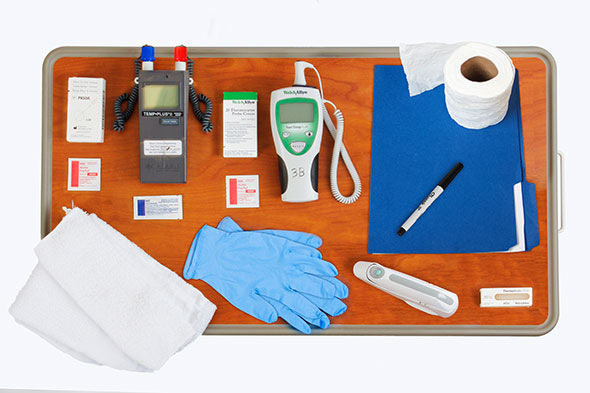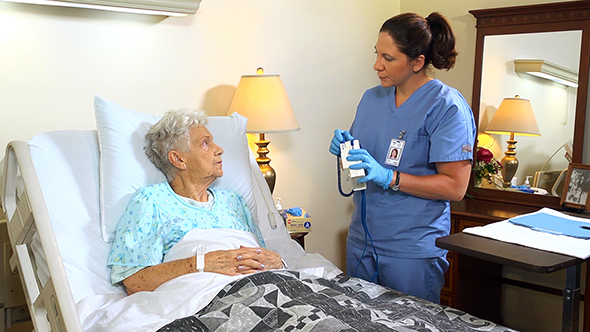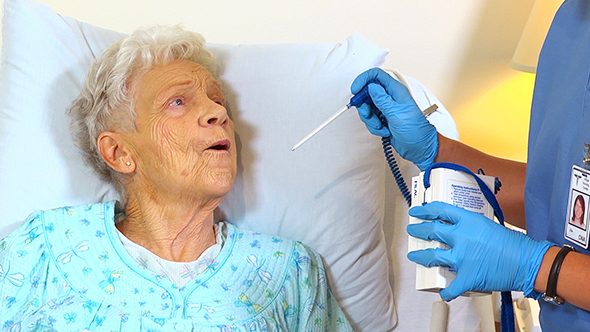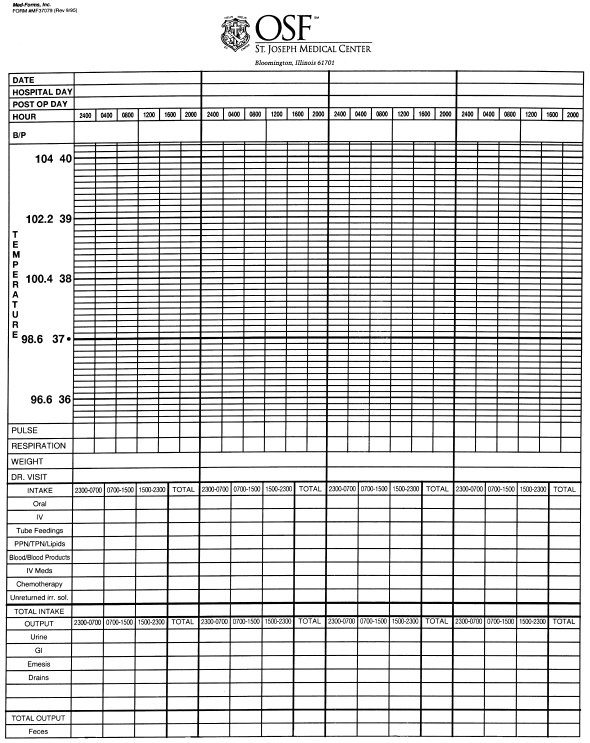Measurements and Vital Signs
Select a Skill:
- » Measuring Weight and Height
- » Taking a Radial Pulse
- » Taking an Apical Pulse
- » Counting Respirations
- » Taking a Temperature with an Electronic Thermometer
- » Measuring Blood Pressure
- » Using a Pulse Oximeter
Take the Review Test:

Purpose

- Body temperature is the amount of heat in the body. It is a balance between the amount of heat produced and the amount lost by the body.
- Body temperature is fairly stable. Various factors affect temperature, such as drugs and pain. However, the normal ranges are:
- 97.6˚ to 99.6˚F (36.5˚ to 37.5˚C) for oral temperature
- 98.6˚ to 100.6˚F (37.0˚ to 38.1˚C) for rectal temperature
- 96.6˚ to 98.6˚F (35.9˚ to 37.0˚C) for axillary temperature
- 98.6˚ (37.0˚C) for tympanic membrane temperature
- 99.6˚F (37.5˚C) for temporal artery temperature.
- Fever means an elevated body temperature. Always report temperatures that are above or below the normal range.
- Follow the manufacturer’s instructions and agency procedures to use, clean, and store thermometers.
- Electronic thermometers are commonly used.
- Standard electronic thermometers measure temperature in a few seconds. They have blue probes (oral and axillary) and red probes (rectal).
- Tympanic membrane (ear) thermometers measure temperature in 1 to 3 seconds. They are comfortable and not invasive. There are fewer microbes in the ear than in the mouth or rectum, reducing the risk of spreading infection.
- Temporal artery (forehead) thermometers measure body temperature in 3 to 4 seconds. Non-invasive, they measure the temperature of the blood in the temporal artery. It is the same temperature as the blood coming from the heart. To use one, use the side of the head that is exposed. Place a disposable cap or cover on the thermometer. Place the device in the center of the forehead. Press the scan button. Slide the device across the forehead and across the temporal artery. Release the scan button. Read the temperature display.
Equipment
Roll cursor over items to see labels. For the purposes of clearly depicting the equipment, a barrier is not shown in this photo. When providing care, a barrier should always be placed on the surface before placing the equipment.

Electronic thermometer
Electronic thermometer
Probe (blue for an oral or axillary temperature; red for rectal temperature)
Probe covers
Probe covers
Water-soluble lubricant (rectal temperature)
Alcohol wipe
Alcohol wipe
Chart and pen
Toilet tissue (rectal temperature)
Gloves
Towel (axillary temperature)
Tympanic thermometer
Probe covers
Delegation
- Follow delegation guidelines. Before taking a temperature with an electronic thermometer, obtain this information from the nurse and care plan:
- What site to use for each person
- When to take temperatures
- What persons are at risk for elevated temperatures
- What observations to report and record
- When to report observations
- What patient or resident concerns to report at once
Preparation

- Observe quality-of-life measures.
- Review the information under Delegation and Safety and Comfort.
- For an oral temperature, ask the person not to eat, drink, smoke, or chew gum for at least 15 to 20 minutes before the measurement or as required by agency policy.
- Practice hand hygiene.
- Collect the equipment.
- Plug the probe into the thermometer if using a standard electronic thermometer.
- Identify the person. Check the ID bracelet against the assignment sheet. Also call the person by name.
Safety

- Thermometers are inserted into the mouth, rectum, axilla, or ear. Each area has many microbes. The area may contain blood. Therefore, each person has his or her own glass or digital thermometer. Disposable covers (sheaths) or caps are used for other electronic thermometers. This prevents the spread of microbes and infection. Follow Standard Precautions and the Bloodborne Pathogen Standard.
- The rectal site is dangerous for persons with heart disease. The thermometer can stimulate the vagus nerve. This nerve affects the heart. Stimulation of the vagus nerve slows the heart rate. The heart rate can slow to dangerous levels in some persons.
- With rectal temperatures, your gloved hands may have contact with feces. If so, remove gloves and practice hand hygiene. Then note the temperature on your note pad or assignment sheet. Put on clean gloves to complete the procedure.
Comfort
- Remove the thermometer promptly. Do not leave it in place longer than needed. This affects comfort.
Procedure Video
Audio Description: OFFFollow-up Care

- Provide for comfort.
- Place the call light within reach.
- Unscreen the person.
- Complete a safety check of the room.
- Disinfect the probe following agency policy and the manufacturer’s instructions.
- Return the thermometer to the charging unit.
- Practice hand hygiene.
Reporting/Recording
- Report and record the temperature, including the temperature site.
- Report an abnormal temperature at once:
- A temperature that is changed from a past measurement
- A temperature above or below the normal range for the site used
Review Questions
Select the best answer.
1. Which of these sites is the least invasive for taking a temperature with an electronic thermometer?
Select the best answer.
2. How should you position a person for rectal temperature measurement?
 In the side-lying position
In the side-lying position In the prone position with the legs apart
In the prone position with the legs apart In the semi-Fowler’s position with the knees bent
In the semi-Fowler’s position with the knees bent In the supine position with the head of the bed elevated
In the supine position with the head of the bed elevated
Select the best answer.
3. What is the normal range for an oral temperature?
Select the best answer.
4. Which temperature site is measured in the underarm?
Select the best answer.
5. Which site for temperature measurement can be dangerous for persons with heart disease?
You have completed the Review Questions for this skill. To take the Review again select the Start Over button. To proceed to another skill select from the dropdown menu. Select the Home or Back button to proceed to the next section.

